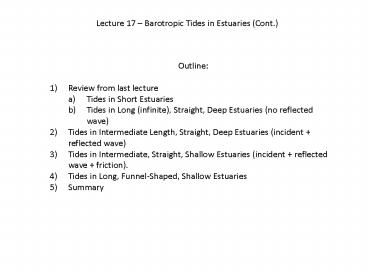Lecture 17 Barotropic Tides in Estuaries Cont' PowerPoint PPT Presentation
1 / 14
Title: Lecture 17 Barotropic Tides in Estuaries Cont'
1
Lecture 17 Barotropic Tides in Estuaries (Cont.)
- Outline
- Review from last lecture
- Tides in Short Estuaries
- Tides in Long (infinite), Straight, Deep
Estuaries (no reflected wave) - Tides in Intermediate Length, Straight, Deep
Estuaries (incident reflected wave) - Tides in Intermediate, Straight, Shallow
Estuaries (incident reflected wave friction). - Tides in Long, Funnel-Shaped, Shallow Estuaries
- Summary
2
Short Estuaries
Only need continuity to describe tides
Cross-sectionally averaged continuity
Rate of change of cross-sectional area
along-channel flux convergence
Surface area of estuary
Cross-sectional area of estuary
No bathymetric convergence decreases velocity
along system.
Bathymetric convergence maintains relatively
uniform velocity along system.
U(x)
U(x)
Gives Standing Wave Relationship ? 90
3
Long, Deep, Straight Estuaries
Continuity
Along-channel momentum
Phase speed
Ignoring reflected wave gives a progressive wave
with Phase (F) 0
4
But this ignores reflection.
Lowest order momentum balance
Lowest order continuity
No friction!
This is second-order wave equation. This allows
waves to propagate in either direction (x or
x).
This allows tidal wave to reflect at head of
estuary and propagate out. This will not occur
if frictional damping is too strong, or if there
are rapid changes in estuary width.
5
Governing equations
General Solution
L is length of estuary
incident wave reflected wave
Boundary Condition
Solution
This gives standing wave (? 90)
6
Second order wave equation describes incident and
reflected wave
These waves combine to create a standing wave.
7
Solution
What happens if kL p/2 ?
cos(p/2) 0
Solution for ? and u go to infinity.
Quarter wave resonance
Definition of k
When length of the estuary is ¼ the length of the
tidal wave, resonance significantly amplifies the
tide.
Example Bay of Fundy (tides exceed 17 meters at
the head of the Bay)
Assume shallow water wave speed
Depth at mouth 100 m
8
Length of Bay is roughly 350 km
9
Why arent the tides in the Bay of Fundy Bigger?
Solution neglects friction, which will become
important as velocities increase
Lowest order momentum balance
Lowest order continuity
Linearized friction
Solution becomes
Where
Friction parameter
This gives phase (0 lt ? lt 45) for the incident
wave
10
Damped Oscillator
11
Tides in Long, Shallow, Funnel-Shaped Estuaries
Delaware Bay
wo
Approximate shape (Lb is efolding length for
changes in channel width)
Many systems have convergent width.
12
Tides in Long, Shallow, Funnel-Shaped Estuaries
(cont.)
Scaling Continuity
assume changes in depth, U and 1/k are all
smaller than changes in width, and that Lw Lb.
Tidal elevation is defined to be
Phase is standing relation (F 90)
Standing relationship does not occur because of
the superposition of an incident and reflected
wave!
Occurs because of the convergence caused by
along-channel decrease in width.
13
Tides in Long, Shallow, Funnel-Shaped Estuaries
(cont.)
Momentum
Assume that for shallow systems, friction is more
important than local acceleration
Lowest order balance
From continuity
by definition
Combine Momentum and Continuity
or
This is a first order wave equation. Waves can
only travel in one direction. Reflected waves
(negative x-direction) dont occur because their
energy is spread by the divergence in width and
it is damped by friction. Waves in positive
x-direction are damped frictionally, but
convergence in width concentrates energy enough
to maintain constant wave amplitude.
14
Summary
- Tides in short estuaries Elevation is
essentially uniform along system because LltltLt.
Based on continuity alone, it can be shown that
short estuaries have standing wave relationship.
When water is flowing in, surface is going up. - Tides in deep, straight, and infinitely long
estuaries Friction is not important so wave
propagates into the estuary without decay. This
results in a progressive wave relationship, in
the absence of reflection. (This is not very
realistic, because without frictional decay there
would be energy to be reflected). - Tides in deep, straight and intermediate length
estuaries Friction is not important so wave
propagates in and is reflected at head. Without
friction this leads to a standing wave
relationship. Also allows for quarter wave
resonance when L Lt/4. - Tides in shallow straight and intermediate length
estuaries Friction damps the wave as it travels
into the estuary. If it is not completely damped
frictionally, it will reflect at head. Friction
acting on incoming wave leads to a phase between
0 (no friction) and 45 (strong friction). - Tides in shallow, long funnel-shaper estuaries
As wave propagates into estuary it is
frictionally damped, but convergence due to the
decrease in width concentrates energy to maintain
constant wave amplitude. This leads to a standing
wave relationship (? 90). Reflected waves
dont propagate because energy is spread by the
divergence in width (and damped by friction).

